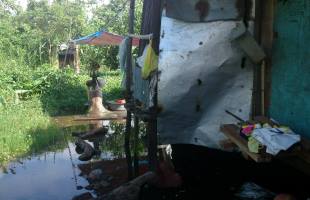
World Water Day is celebrated every 22nd of March to raise awareness on water related issues. For this year, the theme of World Water Day is “Why Wastewater”. Globally, more than 80% of the wastewater generated by the people and economic activities flows back into the ecosystem without being treated or reused, this puts around 1.8 billion people who drink from untreated sources at risk of contracting cholera, dysentery, typhoid and polio. Unsafe water, poor sanitation and hygiene cause around 842 000 deaths each year.
Wastewater is composed of liquid waste coming from the toilet, bathroom, laundry, and kitchen of a household. It is usually deposited in septic tanks or disposed through sewer lines. Economic (e.g. agriculture, manufacturing, mining) and institutional (e.g. offices, hospitals, schools) activities also produce wastewater which have to be collected and treated to avoid environmental pollution and risks to health.
According to Engineer Bonifacio Magtibay, WHO Technical Officer for Environmental Health, wastewater may contain toxic chemicals, hazardous and organic substances, and pathogenic organisms. If left untreated, this will create problems to ecosystems and people’s health. To solve wastewater concerns, efficient sanitation systems are needed. Sanitation provides a solution for separating pathogenic organisms and harmful chemicals and substances from human contact.
In the Philippines, less than 10% of the population has access to piped sewerage systems. For populations without access to a sewerage system, septic tanks are the main sanitation technology to contain wastewater both in urban and rural areas. In addition to this, 7 million Filipinos reportedly resorted to open defecation in 2015 while 19 million are still using unimproved sanitation facilities. According to the Department of Public Works and Highways (DPWH), the effects of this kind of neglect results in economic losses exceeding 78 billion pesos per year and 55 deaths per day, as well as damage to ecosystems and biodiversity.
To address wastewater and sanitation issues, the government has embarked on an ambitious National Sewerage and Septage Management Program (NSSMP) with a goal of improving water quality and protecting public health in urban areas of the Philippines by 2020. NSSM aims to enhance the ability of local implementers to build and operate wastewater treatment systems and promote the behavior change and supporting environment needed for systems to be effective and sustainable (DPWH, 2013). In addition, the Department of Health (DOH) developed in 2010 the National Sustainable Sanitation Program (NSSP) to focus on rural sanitation.
WHO Country Office in the Philippines supports the government efforts on improving the country’s sanitation and public health. In 2014, WHO partnered with the Asian Development Bank (ADB) and DOH to pilot Sanitation Safety Planning (SSP) in selected water utilities: Baliwag Water District and Maynilad Water Services Incorporated. SSP is an approach that applies risk assessment and management in every critical point of the sanitation chain from household to recycling and reuse to protect the exposed population from disease. Lessons learned from SSP piloting were used in the Sanitation Safety Planning Manual of WHO. It also led to the formulation of Sanitation Safety Planning Project (Phase 2) which aims to come up with scalable models of SSPs that can be used by key stakeholders that manage sanitation systems and services.
In the era of Sustainable Development Goals (2016-2030), it can be noted that SSP can contribute to the achievement of SDG 3 and SDG 6, such as:
- SDG 3.9. By 2030, substantially reduce the number of deaths and illnesses from hazardous chemicals and air, water and soil pollution and contamination.
- SDG 6.2. By 2030, achieve access to adequate and equitable sanitation and hygiene for all, and end open defecation , paying special attention to the needs of women and girls and those in vulnerable situations
- SDG 6.3. By 2030, improve water quality by reducing pollution, eliminating dumping and minimizing release of hazardous chemicals and materials, halving the proportion of untreated wastewater, and substantially increasing recycling and safe reuse globally
If we are able to eliminate open defecation while making sure that wastewater is efficiently treated, associated death and illnesses will be significantly reduced.
Dr Gundo Weiler, WHO Country Representative in the Philippines said, “WHO is committed to support the government in developing the capacity of key stakeholders in the country on sanitation safety planning to protect the health of the population that are exposed to the risks of pollution generated by the households and economic activities”.
References
- ADB (2016). A Guide to Sanitation Safety Planning in the Philippines. Asian Development Bank, Mandaluyong City, Philippines. https://www.adb.org/publications/guide-sanitation-safety-planning-philippines
- DPWH (2013). National Sewerage and Septage Management Program Operations Manual. Department of Public Works and Highways, Manila Philippines. http://www.dpwh.gov.ph/dpwh/sites/default/files/Program%20Operations%20Manual.pdf (accessed, 18 March 2017)
- Sato T, Qadir M, Yamamoto S, Endo T, Zahoor A (2013). Global, regional, a country level need for data on wastewater generation, treatment, and use. Agricultural Water Management 130, 1-13.
- WHO (2014), Preventing diarrhoea through better water, sanitation and hygiene: exposures and impacts in low- and middle-income countries. http:// apps.who.int/iris/bitstream/10665/150112/1/9789241564823_eng.pdf
- WHO/UNICEF (2014), Progress on drinking water and sanitation: 2014 update. https://www.unicef.org/gambia/Progress_on_drinking_water_and_ sanitation_2014_update.pdf
- WHO (2015). Sanitation safety planning manual for safe use and disposal of wastewater, greywater and excreta. Geneva. http://www.who.int/water_sanitation_health/publications/ssp-manual/en/
- WHO/UNICEF (2015). Progress on sanitation and drinking water : 2015 update and MDG assessment. Geneva.
